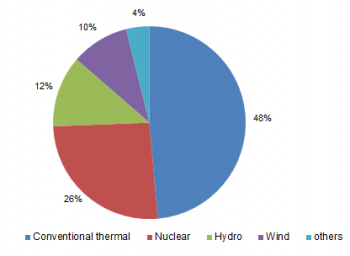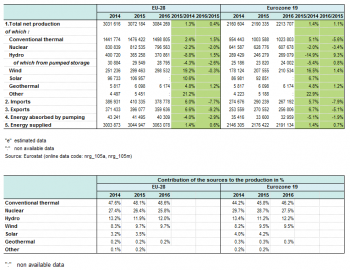Archive:Electricity generation statistics – first results
- Data extracted in May 2017. Most recent data: Further Eurostat information, Main tables and Database. Planned article update: May 2018.
This article takes a look at the most recent statistics (2016 monthly cumulated data and provisional 2016 annual data as voluntarily supplied by Member States) on the volumes of electricity that have been produced and supplied at the level of the European Union (EU-28), the euro area (EA-19) and at the level of the individual Member States of the EU-28 and of Norway and Turkey. For years before 2016, annual data have been used.
As illustrated by Figure 1, the supply of electricity in EU-28 increased by 0.6 % in 2016 compared to 2015. Member States report bigger values annualy than monthly. Reasons for this vary from Member State to Member State. The biggest difference is caused by Germany which reports on a monthly basis electricity generated only in main activity producer plants.

(in GWh)
Source: Eurostat (nrg_105a), (nrg_105m)
Main statistical findings
Production of electricity
After an increase of 1.3 % in 2015, the volume of produced electricity at EU-28 level increased once again in 2016 by 0.4 % compared to the preceding year.
Table 1 shows the production and supply data for EU-28 and euro area (EA-19). Tables A to J (see: Source data for tables, figures and maps on this page (MS Excel)) show the production and supply data for all individual EU Member States and for Norway and Turkey, by using monthly cumulated data for 2016 (2014 and 2015 data are annual figures).
Latvia (22.3 %), Belgium (17 %), Portugal (15 %), Estonia (15 %), Croatia (13 %), Austria (11.2 %) and Slovenia (8.8 %) are the Member States that recorded the largest increases in electricity production. Against this trend, Malta (-31.6 %), Luxembourg (-19.8 %), Lithuania (-13.4 %) and Bulgaria (-9.5 %) decreased the most significantly their electricity production. Norway (+0.6 %) and Turkey (+5 %) increased their electricity production.
As regards the structure of electricity production in 2016 (Figures 2 and 3):
- the production of conventional thermal electricity increased by 1.5 % in the EU-28 and accounted for 48.6 % of total production;
- the production of electricity by nuclear power plants decreased in the EU-28 in 2016 (-2 %) and accounted for 25.8 % of the total;
- the electricity production by hydro which includes pumped hydro (not necessarily of renewable origin) increased by 1.5 % and represented 12 % of the total production while the production by wind decreased in the EU-28 by 0.3 % and represented 9.7 % of the total production;
- the electricity production by solar is not available in the monthly cumulated data.
The electricity produced by nuclear power plants decreased (-2 %) between 2015 and 2016. The largest share of electricity produced by nuclear in the 14 EU Member States that have nuclear facilities to produce electricity can be found in France (72.3 %), followed by Slovakia (56.6 %), Belgium (51.7 %), Hungary (51.4 %), Sweden (40 %), Bulgaria (36.9 %), Slovenia (35.2 %) and Finland (33.7 %). In Germany that has decided to close down its nuclear power plants during the next decade, the share of nuclear is 13.1 % of the total.
Electricity supplied to the market
The volume of electricity that is supplied to the market is defined as the total net volume of produced electricity minus export plus import minus the electricity that is absorbed by pumping (pumped storage). As illustrated in Figure 1, the supply of electricity in EU-28 increased by 0.6 % in 2016 compared to 2015.
When looking at supply statistics at national level, the most important increases were observed in Cyprus (+7.5 %), Austria (+6.9 %), Slovakia (+6.3 %), Lithuania (+5.2 %), Latvia (+5.1 %) and Malta (+3.6 %). In Turkey, the supply increased by 5.3 % compared to 2015 and in Norway it increased by 0.1 %.
The largest decreases in supply figures were observed in Belgium (-3.7 %), Italy (-2.1 %), United-Kingdom (-2 %) and Greece (-0.9 %).
In 2016, the aggregated EU-28 imports and exports of electricity decreased by 7.7 % and 9.2 % respectively.
See also
- Electricity and heat statistics
- Consumption of energy
- Electricity, gas, steam and air conditioning supply statistics - NACE Rev. 2
- Electricity market indicators
- Electricity production, consumption and market overview
- Energy price statistics
- Energy price statistics - background
- Energy production and imports
Further Eurostat information
Publications
- Energy, transport and environment indicators - 2015 edition
- Energy balance sheets 2012-2013 - 2015 edition
Main tables
- Energy (t_nrg), see:
- Energy Statistics - main indicators (t_nrg_indic)
- Market share of the largest generator in the electricity market (ten00119)
- Electricity generated from renewable sources (tsdcc330))
- Energy Statistics - quantities (t_nrg_quant)
- Total gross electricity generation (ten00087)
- Electricity consumption by industry, transport activities and households/services (ten00094)
- Electricity consumption by households (tsdpc310)
- Energy Statistics - prices (t_nrg_price)
- Electricity prices by type of user (ten00117)
Database
- Energy (nrg), see:
- Energy Statistics - main indicators (nrg_indic)
- Market share of the largest generator in the electricity market - annual data (nrg_ind_331a)
- Supply of electricity - monthly data (nrg_ind_342m)
- Energy statistics - quantities, annual data (nrg_quant)
- Energy statistics - supply, transformation, consumption (nrg_10)
- Energy statistics - quantities, monthly data (nrg_quantm)
- Energy statistics - supply, transformation, consumption (nrg_10m)
Dedicated section
Source data for tables, figures and maps on this page (MS Excel)
Methodology / Metadata
- Energy Statistics - Infrastructure - electricity - annual data (nrg_113a) (ESMS metadata file — nrg_quant_esms)
- Energy statistics - supply, transformation and consumption (nrg_10) (ESMS metadata file — nrg_indic_esms)
Other information
- Directive 2009/72/EC of 13 July 2009 concerning common rules for the internal market in electricity
- Regulation (EC) No 1099/2008 of 22 October 2008 on energy statistics
- Regulation (EC) No 713/2009 of 13 July 2009 establishing an Agency for the Cooperation of Energy Regulators
- Regulation (EC) No714/2009 of 13 July 2009 on conditions for access to the network for cross-border exchanges in electricity
- Regulation (EU) No 844/2010 of 20 September 2010 on energy statistics, as regards the establishment of a set of annual nuclear statistics and the adaptation of the methodological references according to NACE Rev. 2


